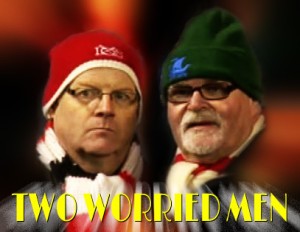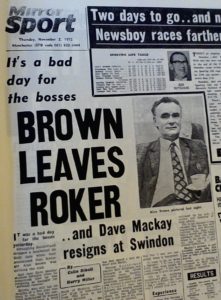
Monsieur Salut writes: scroll down on the right of this article and you’ll find him: the perplexed Coventry fan who wonders that a grudge has been held for all this time: ‘my god, you’ve been keeping this bottled up since the 76/77 season!!!! Any football fan who takes pleasure in another team’s (and not even rivals’) downfall to this degree needs some hobbies…’
‘You know what?’ as they say on X Factor. ‘We have.’ It was blatant cheating, a disgraceful episode and ought to have been punished, even if it has to be accepted that a relegated team also needs to look back on its own failings. Even if no one would have scored a winner anyway. Let Pete Sixsmith bring us up to date, in a rather tantalising way, with his series on Sunderland relegations ….

It took us six seasons and an FA Cup win to drag ourselves out of Division Two and back into the top league. Alan Brown left in October 1972 and was eventually replaced by Bob Stokoe. Under him we won the FA Cup but struggled to go up, missing out on the last day of the 1974-75 season before romping away with the title the following year.
We dropped two points at home all season, and won the league by three points, with Bristol City and West Bromwich Albion trailing us home. A crowd of 51,983 saw us beat Bolton Wanderers to clinch promotion and we wrapped the championship up by beating already relegated Portsmouth 2-0 with goals from Joe Bolton and Billy Hughes.
The prospects looked good. Players had been added throughout that season with Ray Train having an impact at the sharp end and Roy Greenwood (complete with ginger beard) looking to cement a regular place in the line-up. So, we decided not to recruit in the summer, adding only moustachioed Tommy Gibb to the squad, and hoping that a combination of experience and a decent crop of youngsters (Arnott, Brown, Elliott and Rowell) would get us through that tricky first season.
We started off quite well. An opening day draw at the Victoria Ground against the usual collection of grizzled veterans that made up the Stoke City team, was followed by home draws with Leicester City and Arsenal (complete with aerial banners demanding that Terry Neill and Denis Hill-Wood get out of their club), although the day was spoilt by Malcolm Macdonald scoring the Gunners two goals. The first league table of the season saw us sitting reasonably comfortably at 16th and with a few straightforward games to come.
We failed to win any of them. Stokoe entered the transfer market after we slumped to 22nd and, over a few days brought in Bob Lee from Leicester City, Jim Holton and Alan Foggon from Manchester United, and Barry Siddall from Bolton Wanderers.
Bob Lee remains the player with the shortest name ever to wear a Sunderland shirt. He had played well for Leicester earlier in the season and was a big strapping midfielder cum centre forward. He was not prolific, scoring 17 times in 63 games for the Foxes and it was thought that Stokoe had intended to sign Frank Worthington and came back with Lee instead.
He made his debut in early October against Everton, a game remarkable for Joe Bolton dumping Ronnie Goodlass on the running track several times before Goodlass had the last laugh by scoring the winner with an inswinging corner. Memory suggests that Bob didn’t have a great debut…
Jim Holton had signed the week before from Manchester United. He was a fearsome creature who had started as a junior at Celtic at the time of the Lisbon Lions and had departed for a full time career at Shrewsbury Town where he probably enjoyed himself kicking the ball into the River Severn for the man in the coracle to chase. He had moved on to Old Trafford and joined United when they were going through a phase of distinct mediocrity under Tommy Docherty.
He made the Scotland World Cup Squad for the 1974 finals in West Germany and became a fans’ favourite with the Red and Tartan Armies.
“Six foot two, eyes of blue, Big Jim Holton’s after you” rang out into the Mancunian sky and, despite two broken legs in his time there, we thought we had picked up a good ‘un. He was competitive, had a great attitude but his best days were behind him and he only played 15 league games before he sloped off to the newly founded NASL.
Alan Foggon made his debut in the same game as Holton, a 1-1 draw at West Ham at the end of September.
He had made his name in the Newcastle United side that took the Fairs Cup in 1968, scoring a goal as they won in Budapest. He failed to build on that promising start, moved to Cardiff City where he failed completely and then to Ayresome Park where he enjoyed considerable success under the tutelage of Jackie Charlton.
Charlton kept Foggon away from the drink by making him live with the his family in their farmhouse on the moors and he repaid Big Jack by scoring a very respectable 45 goals in 115 games and terrorising opposition full backs (and Teesside pub landlords). But, he faded away and went to the Good Old US of A before deciding that Strongarm was a better drink than Budweiser and signing a deal to play at Manchester United.
He lasted three games at the Then Theatre of Nightmares before pitching up at Roker to become only the third man to play for all three major North East clubs in the 20th Century, after Tommy Urwin and Stan Anderson, but his stay on Wearside was brief and he managed eight games, before he went off to Southend United. He ran the Wheatsheaf in Spennymoor for a while.
Barry Siddall was the pick of the four signings and replaced Monty after the Everton game.
He was a big, solid keeper who had done well at Bolton and who was the right age and the right temperament. Playing behind Sam Allardyce at Burnden Park, he was used to a big, strong centre half and he got one in Jeff Clarke, one of my favourite Sunderland players.
Incidentally, Jeff is now physio at Dundee United – I clocked him in their play-off semi-final with Falkirk and if you watch BT Sport on Thursday, you might see him administering the magic sponge at Tannadice as United take on Hamilton Accies.
Siddall did well for us and made 167 appearances over six years at Roker. Now working as a Royal Mail delivery worker in Lancashire, he looks back fondly on his days at Roker and gets to the Stadium at least once a season. He may well take in games at Bolton and Preston next year.
Despite this influx of players, things got worse and Stokoe left with the team bottom and his new signings, with the exception of Big Barry, looking distinctly second rate.
First team coach Ian McFarlane took over and guided us to our first win of the season at Coventry, 11 games in when goals from Bob Lee (his first) and Billy Hughes lifted us off the bottom. Normal service was resumed the week after when we lost at QPR and Stan Bowles scored a wonderful goal that featured on The Big Match for years to come.
By this time I was working at Ferryhill Comprehensive School, teaching my own idiosyncratic brand of history.
Every child I taught could recite the 1937 FA Cup Winning side and whole swathes of the curriculum were taken up with analysing the socio-economic make up of late Victorian Britain in relation to the Team of All The Talents. I had long hair and a bushy beard and drove a Volkswagen Beetle which I bought from Peter Vardy at Stoneygate. The radio never worked properly despite him promising to fix it for me and I never wore a Reg Vardy shirt when they sponsored us.
They were happy days (I think). Football was the main topic of conversation among the teachers and there was a nucleus of Sunderland supporters in the staff room – Peter Scott, Les Dobson, Arnie Watson, the man who had kept the Royal Navy afloat, and a lovely man called Bill Maughan of whom more later.
McFarlane’s reign came to an end after a miserable defeat at the Baseball Ground and in came Jimmy Adamson who was between jobs, having left Burnley and Sparta Rotterdam in quick succession. He had a reputation as a top class coach and had been wanted by the FA when they booted Walter Winterbottom upstairs in 1963 but he preferred to stay in North East Lancashire and they gave the job to Alf Ramsey instead.
His start was a poor one, losing at St Andrews in a game I remember for the Sunderland fans singing “Amy, Amy Turtle, Amy Turtle on the wing” and he proceeded to lose the next six including one at the Sports Direct.
The slide was halted with two goalless draws at home to Stoke and away to Arsenal, games that rank as two of the worst I have ever seen and we had gone 1,020 minutes without a goal. And then……
We played Bristol City on a Friday night and twenty minutes in Mel Holden scored to give us a win over relegation rivals. It didn’t lift us off the bottom, but the next three games did. All were played at home and we went from goal drought to goal flood, beating Middlesbrough 4-0, West Brom 6-1 (Bob Lee hat trick) and West Ham 6-0. Gary Rowell scored in all three of those games and by the end of those four games we were 18th and out of the brown stuff.
In fact, we only lost three of the last 19 games – at Manchester City, Aston Villa and Everton and, after Tony Towers and Kevin Arnott scored in a 2-1 win over Manchester United, we were sitting pretty in 16th position.
We won 3-2 in a wonderful game at the Hawthorns, with Tony Towers scoring twice and Bob Lee getting the winner. That was the day I first met Sobs and gave him a lift home in the back of the Beetle. We followed up with a home win over Birmingham City and it was all on the last two games of the season – both away, one at Norwich (M Salut having driven up from London for a 2-2 draw we hadn’t seemed likely to get) and one at Everton. Little did we realise the twists and turns that were to come.
To be Continued. Sorry, Coventry fans waiting to pounce but Pete has decided to split this into two halves. You may know what’s coming ….
Superb, can’t wait even though I know the ending!!